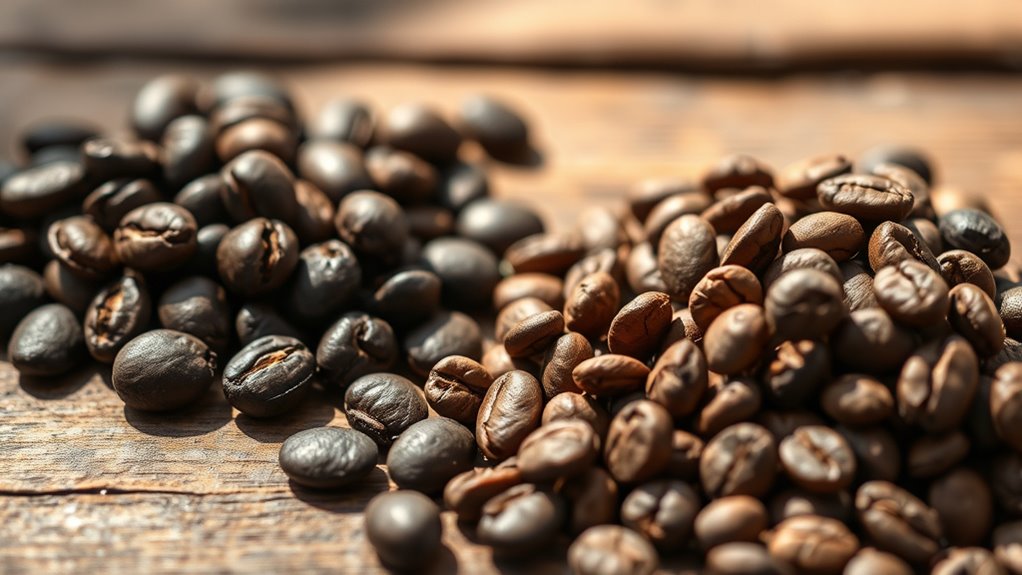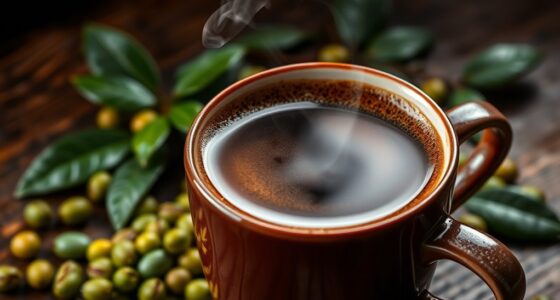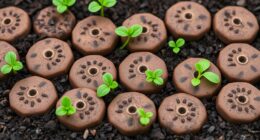The main difference between espresso beans and drip beans comes down to how they’re roasted, ground, and brewed. Espresso beans are usually roasted darker, ground very fine, and brewed under high pressure for a bold, intense flavor. Drip beans are often lighter roasted, ground coarser, and brewed more slowly, resulting in a smoother, more balanced cup. Understanding these differences helps you choose the right beans for your preferred brewing method—if you’re curious, more details await.
Key Takeaways
- Espresso beans are typically roasted darker to produce bold, smoky flavors suited for high-pressure brewing.
- Drip coffee beans are often roasted lighter or medium to preserve bright, fruity, and nuanced flavors.
- The grind size for espresso beans is finer for proper extraction, while drip beans are coarser for consistent brewing.
- Both bean types can come from similar origins but are selected and processed differently based on brewing method.
- The flavor profile, roast level, and grind size are tailored to optimize each brewing method’s characteristics.
The Role of Roast Levels in Coffee Beans
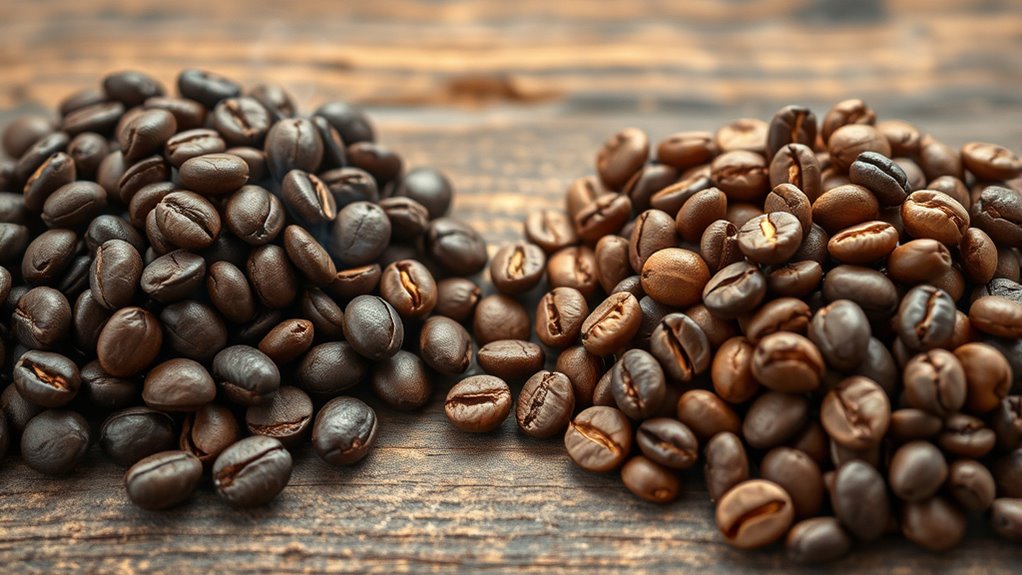
Roast levels play a crucial role in shaping the flavor profile of your coffee beans. The roast level determines how much heat is applied during roasting, directly impacting flavor development. Light roasts preserve more of the beans’ original qualities, highlighting bright acidity and fruity notes. Medium roasts balance acidity with richer, caramelized flavors, offering a smoother experience. Dark roasts undergo longer roasting, creating bold, smoky, and bitter notes, often overshadowing the bean’s natural qualities. Understanding roast levels helps you choose beans that match your taste preferences. Whether you prefer the vibrant brightness of a light roast or the robust body of a dark roast, the roast level is a key factor in achieving your ideal cup. It’s all about how flavor development unfolds through the roasting process. Color accuracy in roasting also influences how true-to-life the beans’ appearance and visual cues are during the roasting process.
Differences in Bean Selection and Origin
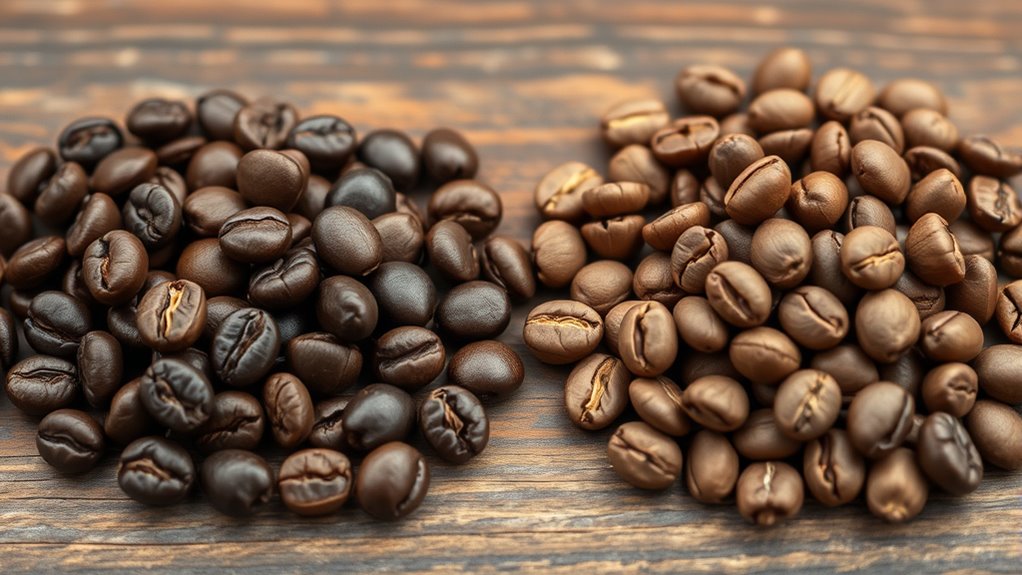
You’ll notice that the beans chosen for espresso and drip coffee often come from different varieties and regions. These differences in origin influence flavor profiles and quality, shaping your overall experience. Understanding where the beans come from helps you pick the right one for your preferred brew. Additionally, selecting beans based on bean origin can enhance your appreciation of unique tasting notes and regional characteristics.
Bean Varieties and Profiles
Different coffee bean varieties and their origins play a crucial role in shaping the flavor profiles of your brew. Single origin beans come from a specific region or farm, offering unique flavors that reflect their environment, such as bright citrus or rich earth tones. These beans allow you to experience the distinct characteristics of a particular terroir. Blended beans combine beans from multiple origins, creating a balanced and complex flavor profile. This approach is popular for both espresso and drip coffees, as it can smooth out regional differences and enhance consistency. Your choice between single origin and blended beans influences the overall taste, aroma, and complexity of your coffee, making it essential to match the bean type with your preferred brewing method and flavor preference. Additionally, understanding the regional flavors associated with different origins can help you select beans that complement your palate.
Geographic Coffee Origins
The origin of coffee beans profoundly influences their flavor, aroma, and overall character. When you explore different regions, you notice distinct regional flavors that reflect the local climate, soil, and elevation. For example, beans from Central America often have bright, fruity notes, while African coffees tend to be more floral and complex. Farming practices also vary by region, affecting bean quality and taste; some areas use traditional methods that enhance unique characteristics, while others focus on high-yield techniques. These differences shape whether your brew is bold, smooth, or vibrant. Understanding geographic origins helps you select beans that match your preferred flavor profile. So, when choosing beans, consider their regional flavor and the farming practices behind them—these elements are key to accessing your perfect cup. Additionally, regional differences are often documented in case studies, providing valuable insights into how specific environments influence coffee quality.
Grind Size and Its Impact on Brewing

Grind size plays a crucial role in determining the flavor and extraction of your coffee, directly affecting the brewing process. When you adjust the grind consistency, you control how evenly the coffee particles are sized, which impacts extraction. Uniform particle size ensures consistent extraction, preventing over- or under-extraction that can lead to bitter or weak flavors. For espresso, you want a fine, uniform grind to allow high pressure to extract rich flavors quickly. For drip brewing, a coarser grind helps water flow smoothly through the grounds, avoiding clogging. Inconsistent grind size can cause uneven extraction and cloudy, bitter, or sour notes. Paying attention to particle size and maintaining a consistent grind ensures you get the best flavor and clarity from your coffee. Consistent grind size is essential for achieving optimal flavor.
The Significance of Brew Time and Pressure
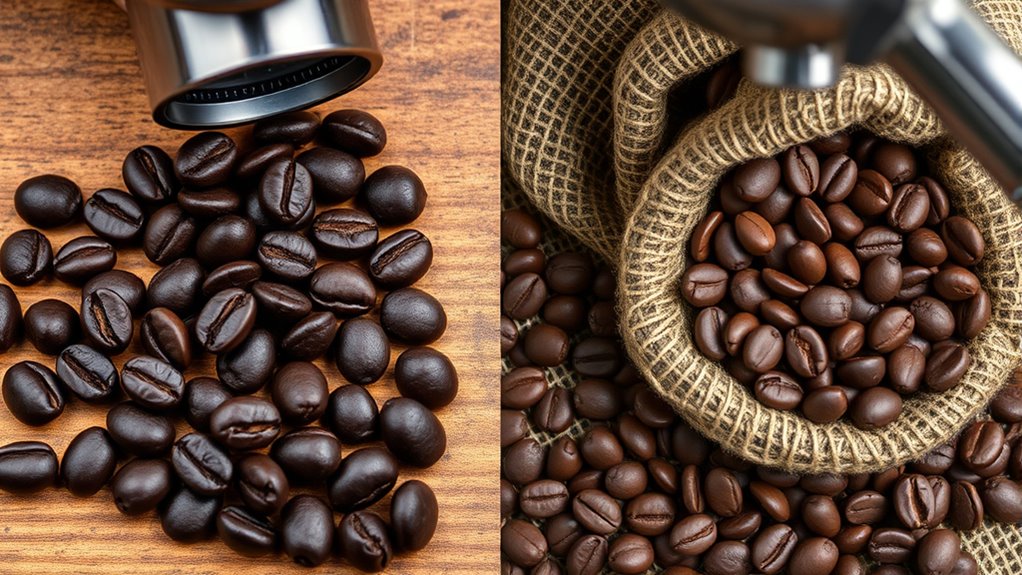
Your brew time and pressure directly influence the flavor and strength of your coffee. Too short or too long extraction can lead to under- or over-extraction, affecting taste. Adjusting these factors helps you find the perfect balance for your preferred brew style. Paying attention to extraction quality ensures a more consistent and desirable coffee experience.
Extraction Duration Impact
Understanding how brew time and pressure influence extraction is vital because they directly affect the flavor and strength of your coffee. If you’re using fresh beans, you’ll want to adjust the brew duration to prevent over-extraction, which can lead to bitterness. Consistent grind size is essential, as uneven grounds cause uneven extraction, impacting flavor. Longer extraction times typically increase strength but risk extracting bitter compounds if the grind is too fine or the beans aren’t fresh enough. Conversely, shorter brew times can result in under-extraction, making your coffee weak or sour. By balancing brew duration with proper grind consistency and considering bean freshness, you guarantee optimal extraction, delivering a well-rounded, flavorful cup every time. Additionally, understanding the regional differences in coffee preferences and brewing techniques can help you tailor your process for the best possible flavor.
Pressure and Flavor Balance
Since pressure plays a essential role in extracting flavors from coffee grounds, balancing it with brew time is crucial for achieving the right flavor profile. The pressure dynamics during brewing influence how solubles dissolve, affecting flavor harmony. Too much pressure or too little brew time can lead to over-extraction, resulting in bitterness, while insufficient pressure or excessive brew time can cause under-extraction, making the coffee weak or sour. For espresso, higher pressure (around 9 bars) ensures a rich, concentrated shot, emphasizing bold flavors. Conversely, drip brewing relies on gravity, with less pressure, producing a lighter, more nuanced cup. Mastering the interplay between pressure and brew duration allows you to fine-tune flavor balance, ensuring your coffee hits the desired taste profile every time. Content optimization techniques can further enhance the clarity and appeal of your brewing process.
Brew Time Variations
Brew time plays a vital role in extracting the right flavors from coffee grounds, especially when combined with pressure. If you rush the process, you might end up with a weak or sour taste, while over-brewing can make your coffee bitter. For espresso, quick extraction ensures a rich, concentrated shot, whereas drip and instant coffee benefit from longer or different brewing times. Keep in mind:
- Shorter brew times highlight bright, acidic notes.
- Longer extraction pulls out deeper, more complex flavors.
- Decaffeinated options may require slight adjustments to extraction time due to different grind sizes or bean types.
Whether you’re brewing regular or decaffeinated coffee, understanding brew time variations helps you achieve your ideal cup—whether it’s bold espresso or a smooth drip brew.
Flavor Profiles: Intensity and Smoothness
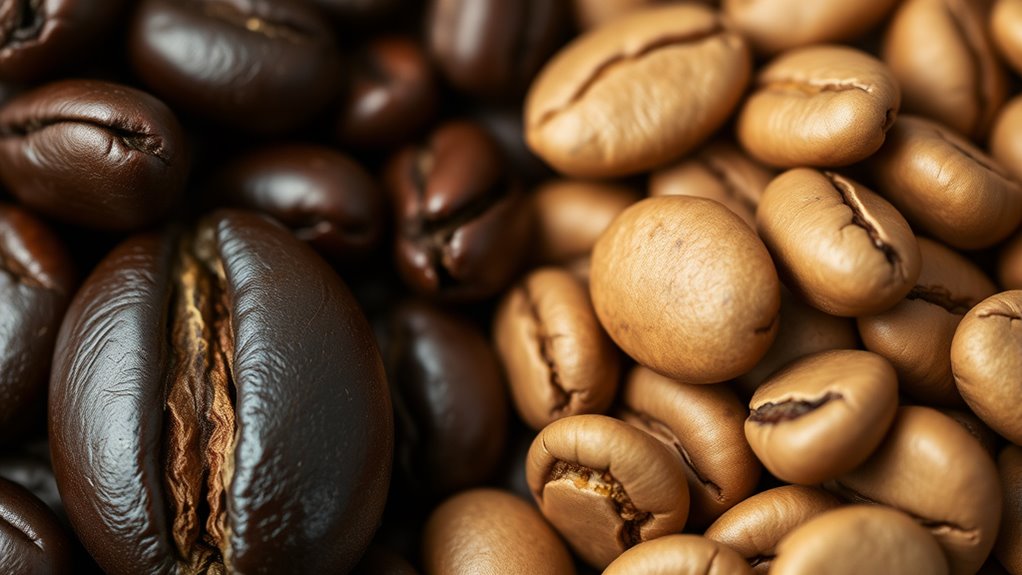
When comparing espresso and drip beans, you’ll notice they deliver distinct flavor profiles, especially regarding intensity and smoothness. Espresso beans tend to produce a bolder, more concentrated flavor with a pronounced intensity that hits your palate quickly. This is partly due to the high-pressure brewing process, which extracts the full flavor complexity, especially from single origin beans. Drip beans, on the other hand, often yield a smoother, more balanced cup, emphasizing subtle nuances and a lighter body. Single origin drip beans can highlight unique flavor notes without the overwhelming intensity of espresso. Your choice depends on whether you prefer a robust, intense experience or a gentle, smooth taste that reveals more delicate flavors. Both methods showcase the distinct qualities of their respective beans. Additionally, understanding the brewing process can help you select the best beans for your preferred coffee style.
Caffeine Content and Perceived Strength
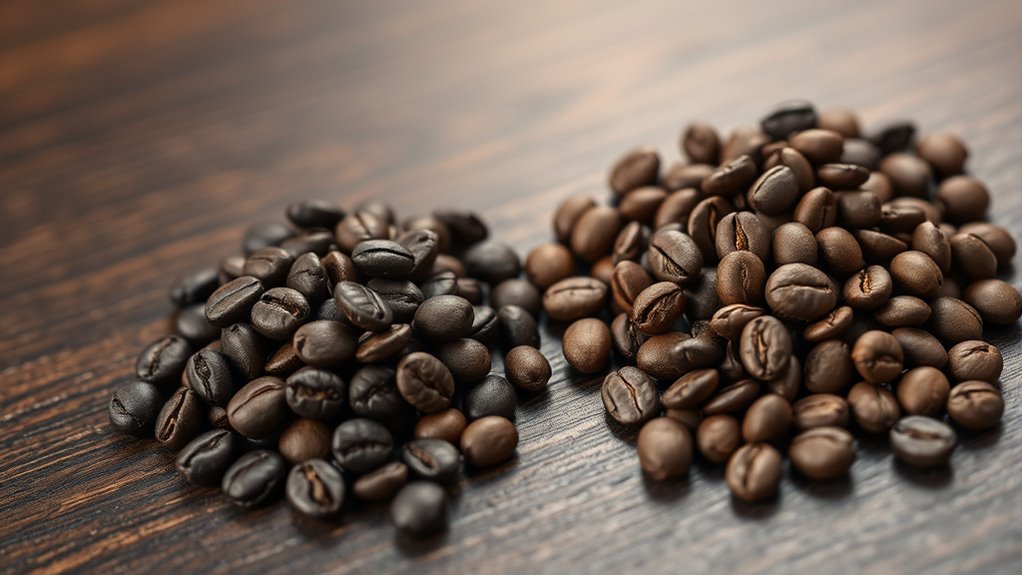
Although both espresso and drip coffee contain caffeine, the perceived strength of each depends on more than just the caffeine amount. Your caffeine perception and strength expectations shape how you experience each brew. For instance, espresso’s bold flavor often leads you to believe it’s stronger, even if the caffeine content isn’t markedly higher. Conversely, drip coffee’s milder taste might make you think it’s weaker, despite potentially having more caffeine overall. Factors influencing your perception include:
- The concentration and flavor intensity of the brew
- The serving size and how the coffee is consumed
- Your personal expectations based on the brewing method
- The perceived quality of the drink, which can influence your sense of strength and satisfaction
Understanding these elements helps you recognize that strength isn’t solely about caffeine quantity but also how your mind perceives it.
Storage and Freshness Considerations
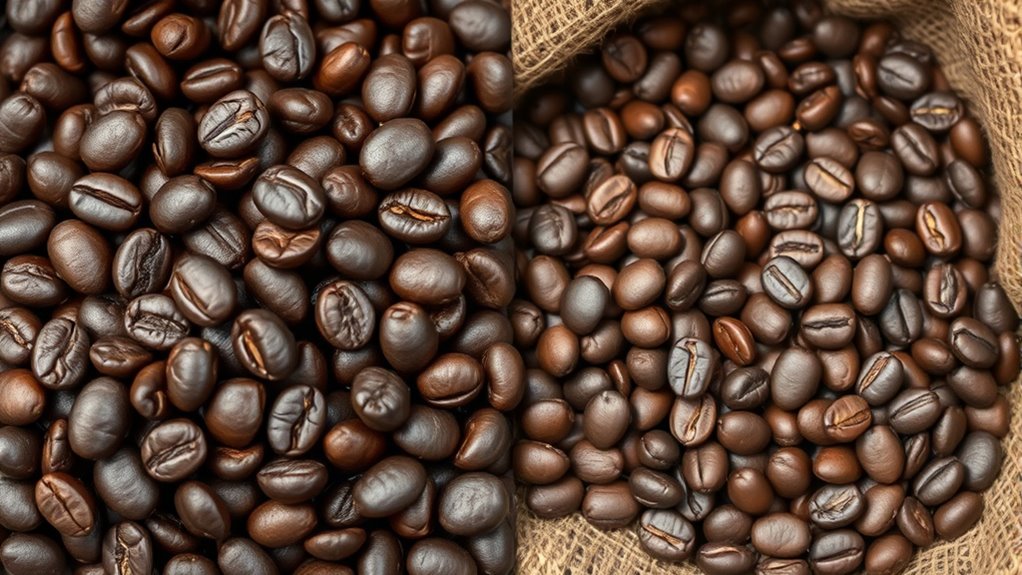
To guarantee your coffee maintains its peak flavor and aroma, proper storage is essential. The right storage conditions help preserve freshness and prevent exposure to air, moisture, heat, and light, which can quickly degrade quality. Keep your beans in an airtight container away from direct sunlight and heat sources. Avoid refrigeration, as moisture and temperature fluctuations can harm the beans’ integrity. Instead, store them in a cool, dark place to maximize freshness preservation. Be mindful of how long beans sit; ground coffee loses flavor faster than whole beans, so grind only what you need. Proper storage ensures your coffee stays flavorful longer, whether you’re brewing espresso or drip coffee. Prioritizing these conditions helps you enjoy a consistent, vibrant cup every time.
Choosing the Right Beans for Your Brewing Method
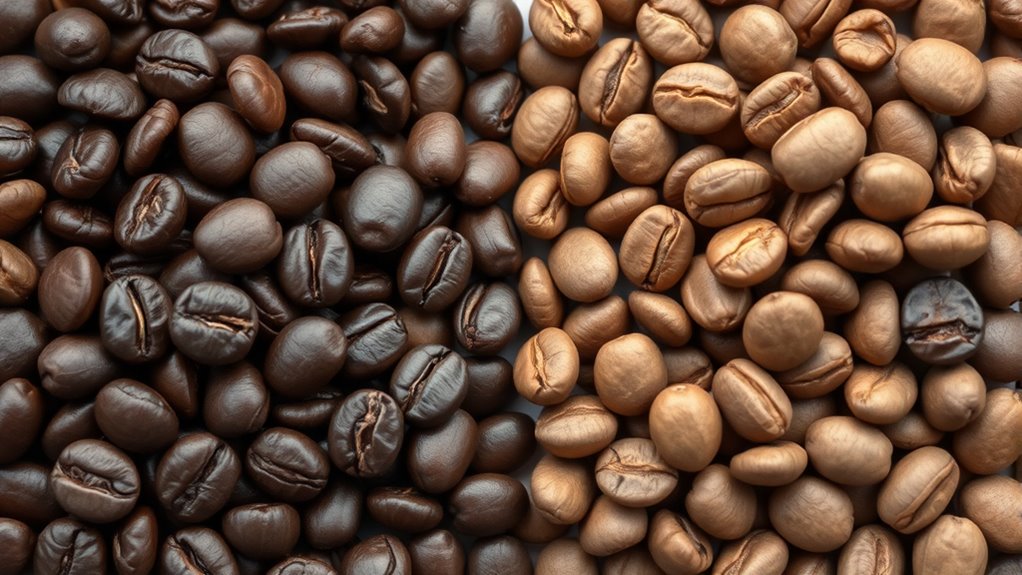
Choosing the right beans for your brewing method can substantially impact the flavor and quality of your coffee. For example, if you’re brewing espresso, opt for beans with a bold, rich profile that complement pairing with desserts, enhancing sweetness and depth. For drip brewing, select beans with a balanced acidity and nuanced flavors that work well with a variety of foods. Consider your brewing equipment compatibility; espresso machines demand finely ground, dark-roasted beans, while drip machines thrive with medium roasts and coarser grinds.
Choosing the right beans enhances flavor, pairing well with desserts and matching your brewing equipment.
- Match roast level to your brewing method
- Think about pairing with desserts for enhanced flavor
- Ensure beans suit your brewing equipment for ideal extraction
Frequently Asked Questions
Do Espresso and Drip Beans Have Different Processing Methods?
You might wonder if espresso and drip beans undergo different processing techniques. They often do, as producers tailor processing to enhance flavor extraction for each brewing method. Espresso beans are usually roasted darker to bring out bold flavors, while drip beans are roasted lighter to preserve nuanced tastes. These processing differences help maximize the flavor profiles suited to each brewing style, making your coffee experience richer and more satisfying.
How Does Bean Size Affect Brewing Quality?
Think of bean size as the brushstroke of your coffee masterpiece. Smaller beans, or a finer grind, promote better grind consistency, leading to more even extraction and a richer flavor. Larger beans require coarser grinding to prevent over-extraction. Proper bean size influences brew temperature stability, ensuring your water interacts uniformly. Adjusting grind size according to bean size helps you perfect your brew, delivering balanced flavors every time.
Can I Use Espresso Beans for Drip Coffee?
Yes, you can use espresso beans for drip coffee, but keep in mind that their flavor profile might be richer and more intense. You’ll want to adjust your bean grind to a coarser setting than usual for espresso so that your coffee doesn’t become overly strong or bitter. The right bean grind impacts your coffee flavor, ensuring you get a smooth, balanced brew even when using espresso beans for drip coffee.
Are There Specific Beans Better Suited for Cold Brew?
Bright, bold, or balanced, your bean selection makes all the difference in cold brew. You should seek out cold brew beans—coarse, smooth, and suited for slow steeping. These beans often have a lower acidity and richer flavor, perfect for cold brew’s gentle extraction. Avoid beans meant for espresso or drip, as they can produce a bitter or overly sharp brew. Choosing the right beans guarantees a satisfying, invigorating cold brew experience.
How Do Bean Freshness and Roasting Date Influence Flavor?
You’ll notice that bean freshness and roasting date greatly influence your coffee’s flavor. When you store your beans properly, they stay fresh longer, preserving their vibrant taste. Freshly roasted beans deliver a richer, more complex flavor, while older beans can taste dull or flat. The roasting impact is key—lighter roasts retain more nuanced flavors, but all beans lose aroma and brightness over time, so using fresh beans enhances your coffee experience.
Conclusion
Understanding the differences between espresso and drip beans helps you brew better coffee. Did you know that espresso beans are often roasted darker, which enhances their bold flavor? Choosing the right beans based on roast level, grind size, and brewing method can make all the difference in your cup. So, next time you brew, remember that small choices shape your coffee’s strength, flavor, and aroma—turning your daily brew into a personalized experience.
